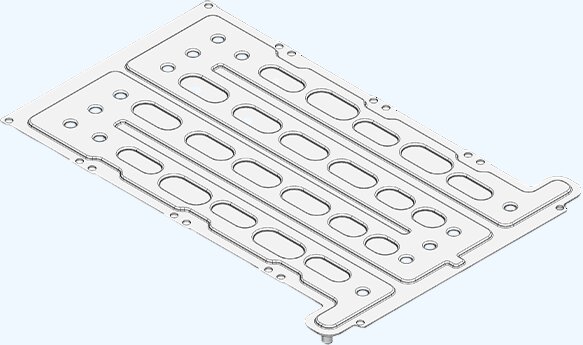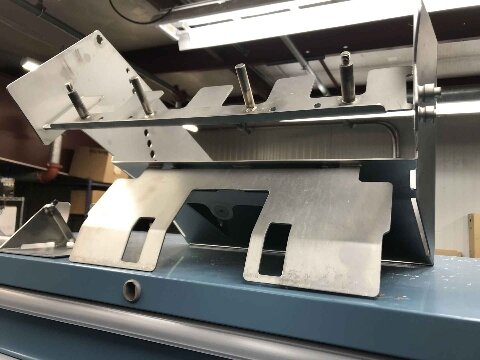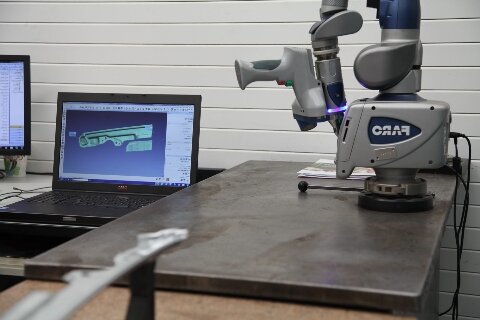제조 분야에서 마감일을 맞추는 것은 결코 쉬운 일이 아닙니다. 촉박한 일정, 복잡한 설계, 갑작스러운 주문 변경으로 인해 생산 팀은 종종 한계에 부딪히게 됩니다. 많은 엔지니어와 관리자가 같은 질문을 합니다: 어떻게 하면 비용 증가나 품질 저하 없이 고품질 판금 부품을 더 효율적으로 생산할 수 있을까요?
오늘날의 시장에서 속도는 중요한 요소가 되었습니다. 고객은 프로젝트의 규모와 범위에 관계없이 더 짧은 리드 타임과 일관된 품질을 기대합니다. 더 빠르게 생산한다는 것은 단순히 더 열심히 일하는 것이 아니라 더 스마트하게 일하는 것입니다. 더 스마트하게 일하는 것입니다. 이를 위해서는 신중한 계획, 더 단순한 설계, 더 나은 기계 및 재료 사용이 필요합니다.
다음 섹션에서는 판금 생산의 효율성을 향상시킬 수 있는 5가지 실용적인 방법을 살펴봅니다. 각 방법은 수요에 발맞춰 더 빠르고 안정적인 공정을 만드는 데 중요한 역할을 합니다.
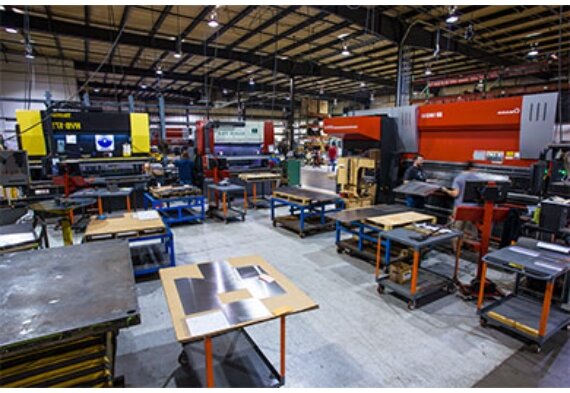
1. 설계 및 엔지니어링 간소화
빠른 생산은 혁신적인 설계에서 시작됩니다. 부품을 쉽게 제조할 수 있으면 설정 시간이 단축되고 제작이 더 빨리 진행됩니다. 엔지니어는 처음부터 부품의 모양과 제조 가능성에 집중하여 작업 시간을 절약할 수 있습니다.
부품 형상 간소화를 통한 제조 속도 향상
형상이 단순하면 생산 속도가 빨라집니다. 여러 개의 굴곡, 컷아웃 또는 비정상적인 각도가 있는 복잡한 부품은 추가 프로그래밍, 설정 및 도구 변경이 필요합니다. 각 단계마다 시간이 추가됩니다. 추가 기능을 줄이고 형상을 깔끔하게 유지하면 기계가 더 효율적으로 작동할 수 있습니다.
부품의 기능에 영향을 주지 않는 장식용 또는 비기능적 기능은 제거합니다. 예를 들어, 두 개의 구멍이 같은 용도로 사용된다면 하나만 남겨두세요. 가능한 경우 곡선 대신 직선을 사용합니다. 레이저 컷 더 쉽게 굽히다.
특별한 도구가 필요한 깊은 구부러짐이나 좁은 모서리는 피하세요. 표준 굽힘 반경으로 설정 속도가 빨라지고 균열이나 뒤틀림이 방지됩니다. 동일한 펀치 또는 레이저 프로그램으로 변경 없이 여러 부품을 처리할 수 있도록 부품 전체에 구멍 크기와 간격을 일관되게 유지합니다.
제조 가능성을 위한 설계(DFM) 원칙 사용
DFM 을 사용하면 엔지니어가 쉽고 비용 효율적으로 생산할 수 있는 부품을 만들 수 있습니다. DFM을 조기에 적용하면 생산 속도를 늦추는 기능을 발견하고 제거할 수 있습니다.
한 가지 핵심 아이디어는 디자인 선택과 작업장의 역량을 일치시키는 것입니다. 예를 들어 벤딩 머신이 1인치 반경에서 가장 잘 작동한다면 특수 공구가 필요한 더 좁은 벤딩은 피하는 것이 좋습니다. 이렇게 하면 지연을 방지하고 부품을 바로 생산에 투입할 수 있습니다.
또 다른 DFM 관행은 재료 두께를 일관되게 유지하는 것입니다. 다른 게이지 사이를 전환하면 기계를 새로 설정해야 하므로 생산 속도가 느려집니다. 여러 부품에 동일한 두께를 사용하면 일괄 처리가 가능하고 유휴 시간 없이 기계를 계속 가동할 수 있습니다.
2. 재료 선택 및 준비
재료 선택은 판금 부품이 생산 과정에서 처리되는 속도에 큰 영향을 미칩니다. 조달과 작업이 용이한 재료를 선택하면 전체 제조 공정이 더 원활해집니다.
즉시 사용 가능한 자료 선택
이미 재고가 있는 재료를 사용하는 것이 리드 타임을 단축하는 가장 빠른 방법 중 하나입니다. 냉연강, 스테인리스강, 알루미늄과 같은 일반적인 금속은 일반적으로 긴 대기 시간 없이 공급업체에서 구할 수 있습니다. 이러한 금속은 널리 사용되고 취급하기 쉬우며 대부분의 제작소에서 지원합니다.
이국적인 합금이나 특수 합금은 강도가 높거나 내식성이 우수할 수 있지만 특별 주문이 필요한 경우가 많습니다. 이러한 자재를 기다리면 프로젝트가 며칠 또는 몇 주까지 지연될 수 있습니다. 엔지니어는 설계를 마무리하기 전에 자재 가용성을 확인하여 이러한 상황을 방지할 수 있습니다.
여러 부품 또는 제품 라인에 걸쳐 소재 선택을 표준화하는 것도 도움이 됩니다. 여러 프로젝트에서 동일한 유형과 두께의 금속을 사용하는 경우, 공장에서 대량으로 주문하고 재고를 유지하며 가동 중단 시간을 최소화하면서 작업 간에 전환할 수 있습니다.
표준 시트 크기 사전 재단 및 사용
재료를 준비하는 데 소요되는 모든 시간은 생산에 낭비되는 시간입니다. 표준 시트 크기와 사전 절단된 블랭크를 사용하면 이를 줄일 수 있습니다. 48인치 x 96인치 또는 48인치 x 120인치와 같은 일반적인 크기는 대부분의 레이저 및 펀치기에 적합하므로 작업자가 트리밍할 필요 없이 직접 로드할 수 있습니다.
표준 시트 치수에 맞게 부품을 설계하면 효율적인 네스팅이 가능하고 낭비를 줄이며 절단 프로세스를 가속화할 수 있습니다. 맞춤형 크기나 비정상적인 레이아웃은 추가적인 취급 및 절단 단계가 필요하므로 생산 속도가 느려지고 비용이 증가합니다.
사전 절단된 블랭크는 대량 생산도 용이합니다. 바로 사용할 수 있는 시트가 있으면 백그라운드에서 새 재료를 준비하는 동안 기계를 계속 가동할 수 있습니다. 따라서 생산량이 안정적으로 유지되고 작업 사이의 긴 중단을 방지할 수 있습니다.
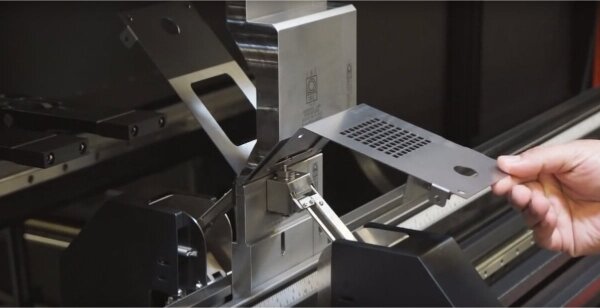
3. 생산 공정 최적화
작업 현장의 워크플로우를 개선하는 것은 판금 생산 효율성을 높이는 가장 빠른 방법 중 하나입니다. 목표는 낭비되는 동작을 최소화하고 가동 중단 시간을 줄이며 기계 효율성을 유지하는 것입니다.
린 제조 기법 구현
린 제조는 부가가치가 없는 모든 것을 제거하는 데 중점을 둡니다. 판금 생산에서 이는 과도한 이동, 대기, 과잉 처리 및 재작업을 줄이는 것을 의미합니다. 부품당 1초가 절약되면 그 효과는 금방 나타납니다.
생산 프로세스의 각 단계를 검토하는 것부터 시작하세요. 자재나 작업자가 유휴 상태로 있는 영역을 찾아보세요. 예를 들어 부품이 검사 또는 도구 설정을 위해 너무 오래 기다리는 경우 해당 단계를 개선해야 합니다. 작업 간 전환을 간소화하면 총 사이클 시간을 줄일 수 있습니다.
작업 공간을 정리하는 것도 중요합니다. 깨끗하고 라벨이 붙은 작업장은 작업자가 도구와 자재를 빠르게 찾을 수 있도록 도와줍니다. 공구를 사용하는 기계 근처에 두면 걸어 다니는 시간이 줄어듭니다. 그림자 보드, 라벨이 붙은 쓰레기통, 시각적 지침도 혼동과 실수를 최소화합니다.
CNC 및 로봇 공학을 통한 반복 작업 자동화
자동화는 반복적이거나 시간이 많이 소요되는 작업의 속도를 높여줍니다. 최신 판금 공장에서 CNC 기계와 로봇 시스템은 절단, 절곡, 자재 취급을 빠르고 정확하게 처리합니다.
CNC 레이저와 펀치는 작업을 설정한 후 수동 입력 없이 복잡한 커팅 프로그램을 빠르게 실행합니다. 자동화된 네스팅 소프트웨어는 시트 사용량을 극대화하고 기계 시간을 줄여줍니다.
로봇 프레스 브레이크는 일관된 벤딩과 반복 가능한 결과를 제공합니다. 특히 자동 툴 체인저와 함께 사용하면 수동 설정보다 빠르게 부품을 전환할 수 있습니다. 자동화는 생산을 안정적으로 유지하고 오류를 줄입니다.
4. 툴링 및 장비 효율성 향상
툴링과 장비는 생산 공정에서 부품이 이동하는 속도에 직접적인 영향을 미칩니다. 기계가 원활하게 작동하고 설정이 빠르면 중단 없이 제작이 이루어집니다.
모듈형 및 퀵 체인지 툴링 시스템 사용
공구 설정은 판금 제조 공정에서 가장 많은 시간을 낭비하는 작업 중 하나입니다. 공구를 교체할 때마다 기계가 멈추기 때문입니다. 모듈식 퀵 체인지 툴링 시스템은 작업자가 더 적은 조정으로 더 빠르게 공구를 교체할 수 있도록 하여 가동 중단 시간을 줄여줍니다.
모듈식 툴링은 동일한 기본 구성 요소를 사용하여 여러 구성으로 작동합니다. 작업자는 전체 공구를 교체하지 않고도 인서트나 섹션을 변경할 수 있어 시간과 비용을 절약할 수 있습니다. 예를 들어, 모듈식 프레스 브레이크를 사용하면 작업자가 교체 가능한 펀치와 다이를 사용하여 다양한 벤드 프로파일을 빠르게 설정할 수 있습니다.
퀵 체인지 클램프, 어댑터 및 정렬 기능으로 더욱 빠르게 설정할 수 있습니다. 작업자는 몇 분이 아닌 몇 초 만에 공구를 배치하고 고정할 수 있습니다. 수동 단계가 줄어들면 정렬이 잘못될 가능성이 줄어들고 생산 속도가 빨라집니다.
최고의 성능을 위한 장비 유지 관리
아무리 좋은 기계도 적절한 유지보수를 하지 않으면 속도가 느려집니다. 정기적인 유지보수는 일관된 성능, 정확한 부품, 예기치 않은 고장 감소를 보장합니다. 유지보수를 건너뛰면 수리 비용과 생산 시간 손실로 이어질 수 있습니다.
일일 점검에는 이물질 청소, 도구 검사, 정렬 상태 확인이 포함되어야 합니다. 마모된 펀치, 무딘 커팅 헤드 또는 느슨한 고정 장치는 부품 품질 저하와 재작업의 원인이 될 수 있습니다. 사소한 문제를 조기에 해결하면 나중에 시간을 절약할 수 있습니다.
예약된 예방 유지보수를 통해 주요 구성품의 상태를 양호하게 유지할 수 있습니다. 필터 교체, 윤활 시스템 점검, 센서 캘리브레이션은 모두 안정적인 작동을 지원합니다. 디지털 로그를 사용하여 유지보수를 추적하면 반복되는 문제를 발견하고 다운타임을 보다 효율적으로 계획할 수 있습니다.
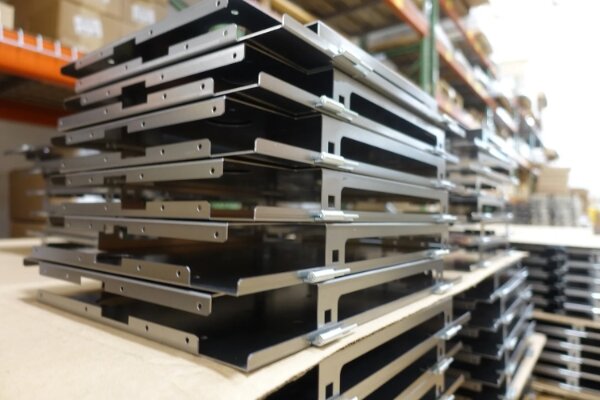
5. 품질 관리 강화
품질 관리는 판금 생산의 속도와 신뢰성 모두에 영향을 미칩니다. 문제를 조기에 발견하면 자재 낭비와 값비싼 재작업을 방지할 수 있습니다.
프로세스 중 검사로 오류를 조기에 감지하기
생산 중에 오류를 발견하면 마지막에 발견하는 것보다 더 많은 시간을 절약할 수 있습니다. 공정 중 검사를 통해 부품이 다음 생산 단계로 넘어가기 전에 치수 또는 표면 문제를 파악할 수 있습니다. 이를 통해 전체 배치가 폐기되거나 재작업되는 것을 방지할 수 있습니다.
작업자는 각 단계가 끝난 후 구멍 배치, 굽힘 각도 및 평탄도와 같은 주요 특징을 바로 확인할 수 있습니다. 이러한 검사는 도면의 허용 오차와 일치해야 합니다. 특정 부품을 위해 특별히 설계된 게이지나 템플릿을 사용하면 빠르고 쉽게 검사할 수 있습니다.
생산에 검사를 포함하면 문제가 발생하는 지점에서 문제를 포착할 수 있습니다. 예를 들어 굽힘 각도가 잘못된 경우 작업자는 최종 조립 중에 문제를 발견하는 대신 프레스 브레이크를 즉시 조정할 수 있습니다. 이를 통해 워크플로우를 원활하게 유지하고 낭비를 줄일 수 있습니다.
일관성을 위한 디지털 측정 도구 사용
디지털 도구는 측정을 가속화하고 정확도를 향상시킵니다. 기존의 캘리퍼와 수동 게이지도 효과적이지만 디지털 시스템은 특히 복잡한 부품이나 공차가 엄격한 부품에 대해 더 빠르고 신뢰할 수 있는 데이터를 제공합니다.
좌표 측정기(CMM)레이저 스캐너, 디지털 높이 게이지를 사용하면 부품 형상을 빠르게 확인할 수 있습니다. 이러한 도구는 몇 초 만에 여러 치수를 캡처하여 수동 측정의 필요성을 줄여줍니다. 또한 데이터를 자동으로 저장하여 시간 경과에 따른 품질 추세를 추적하는 데 도움이 됩니다.
디지털 측정 도구를 생산 소프트웨어와 연결하면 엔지니어는 즉각적인 피드백을 받을 수 있습니다. 부품이 공차를 벗어난 경우 작업자는 더 많은 부품에 영향을 미치기 전에 문제를 해결할 수 있습니다. 이러한 실시간 가시성은 더 빠른 의사 결정과 원활한 워크플로우를 지원합니다.
다음 프로젝트를 가속화할 준비가 되셨나요? 지금 부품 도면 또는 3D 파일을 공유하세요.. 엔지니어링 팀이 설계를 검토하고 시간을 절약할 수 있는 방법을 제안하며 빠르고 정확한 견적을 제공하여 일정에 맞춰 제작할 수 있도록 도와드립니다.
안녕하세요, 저는 케빈 리입니다

지난 10년 동안 저는 다양한 형태의 판금 제작에 몰두해 왔으며 다양한 워크숍에서 얻은 경험에서 얻은 멋진 통찰력을 이곳에서 공유했습니다.
연락하세요

케빈 리
저는 레이저 절단, 굽힘, 용접 및 표면 처리 기술을 전문으로 하는 판금 제조 분야에서 10년 이상의 전문 경험을 갖고 있습니다. Shengen의 기술 이사로서 저는 복잡한 제조 문제를 해결하고 각 프로젝트에서 혁신과 품질을 주도하는 데 최선을 다하고 있습니다.

